NestWatchers Document Rare Use Of Nest Boxes By House Finches
July 22, 2022
An Unexpected Family
In 2022, House Finches raised two successful broods of five inside one of Lee's bluebird boxes. The entrance hole diameter of this box is 1 1/2".
By Robyn Bailey, NestWatch Project Leader
House Finches are one of the most common birds found nesting on and around human habitations from southern Canada extending all the way to southern Mexico. Their abundance and adaptability when nesting near people has made them one of the best-studied birds in North America, and yet they are still capable of surprising us.
People have been placing nest structures to attract House Finches since at least 1908 (Bergtold 1913), so they have nested alongside us for more than a century. Because the House Finch was originally native to western North America, its colonization of the east from the 1940s through the 1980s (by both introduction and natural range expansion) caused some easterners concern that they would compete for nest boxes and natural cavities (Jackson et al. 1986).
So far, this dire prediction has not come to pass. In fact, when House Finches nest in an enclosed nest box, it is rare enough to stand out—only a few NestWatchers have reported this. It is similarly rare among those who recorded for the Cornell Lab of Ornithology’s historical North American Nest Record Card Program. The House Finch is not an obligate cavity-nester like woodpeckers, Purple Martins, and Wood Ducks. They can choose to make a cup nest in vegetation or on human-made buildings, or even in the old nests of other birds. Because they do not require a cavity, their occurrence in nest boxes is a novelty rather than the norm.
Lee’s California Finches
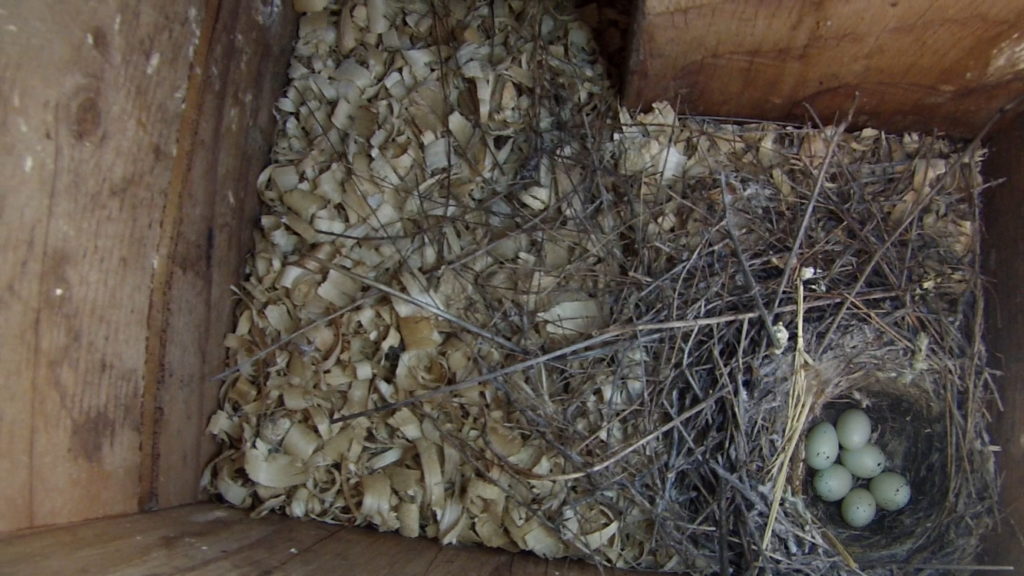
A Spacious Choice
In 2014, House Finches made a nest inside one of Lee Pauser's Barn Owl nest boxes. They did so again the next year, and also tried out one of his American Kestrel nest boxes as well.
In 2014 and 2015, Lee Pauser witnessed House Finches making a total of 12 nests inside American Kestrel and Barn Owl nest boxes on his California trails. Lee monitors hundreds of nest boxes every summer, but this struck him as unusual. Because these boxes are for larger-bodied birds and the nests were near the entrance, Lee hypothesized that the finches must like a lot of light.
That theory came into question on April 12, 2022 when he found his very first House Finch nest inside a bluebird box. This nest contained five eggs which eventually hatched and fledged. A second brood was attempted, and it was also successful. For those counting, this brings Lee’s total to 14 nests inside nest boxes. This surely is a localized breeding behavior, perhaps something that his local finches have learned from one another? Given the many thousands of NestWatchers monitoring bluebird boxes, if finches were using them with any regularity, this would show up in the data; however, it remains a rarely-reported event.
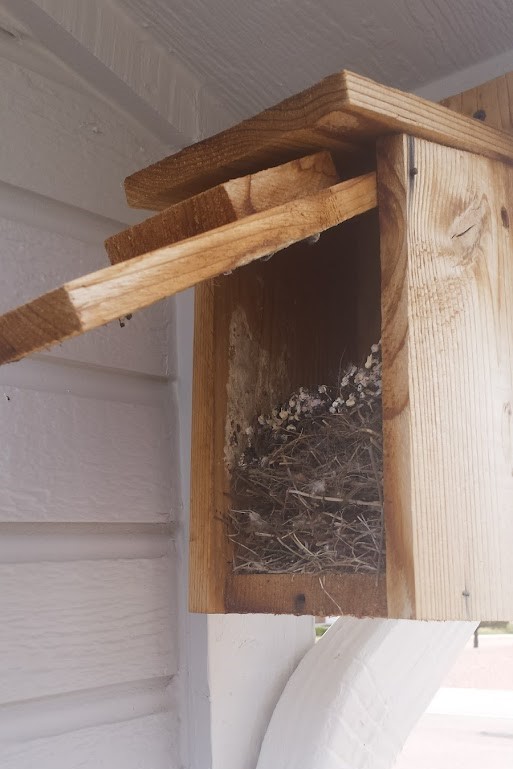
Igniting A Passion
Ethan's observations started in 2018, when a House Finch used this traditional songbird nest box mounted under his home's eaves. Monitoring their nests helped ignite his passion for assisting these birds.
Meanwhile In Colorado
In 2018, NestWatcher Ethan Heinold noticed a House Finch using a traditional nest box mounted under the eaves of his home. This nest was successful, and the box even sheltered the finch family through a late spring snowstorm that year. Ethan found it curious that they chose to use the fully enclosed nest box, despite there being a more open nest shelf nearby.
Ethan’s interest in the little birds was piqued years ago when he noticed House Finches inspecting porches, gutters, and eaves around the neighborhood for suitable nesting sites. As he put it, “Once I noticed this, I wondered if I could build them a place to nest. My first design attracted a pair, and they built a nest so I kept experimenting.” His original designs were more open, and were attractive to the finches; however, the local Woodhouse’s Scrub-Jays were clever enough to figure out their purpose and raid the boxes. After trying three other styles, he has recently settled on a style he calls the “eavebox,” which resembles a nest box with a triangular opening mounted face down. The bottom-facing entrance has been effective at stopping scrub-jays from entering, and allows the finches a quiet crevice in which to nest.
How lucky are Ethan’s local finches to have their own personal builder who iteratively creates ever-improving nest boxes for them? Perhaps other NestWatchers will want to follow suit and experiment with this fairly simple design mounted on their own homes. Ethan notes that there are not many House Sparrows in his neighborhood, so he has not yet witnessed any competition for the eavebox. If you decide to use a nest structure like this, we welcome you to tell us about your experience!
Flexible Finches
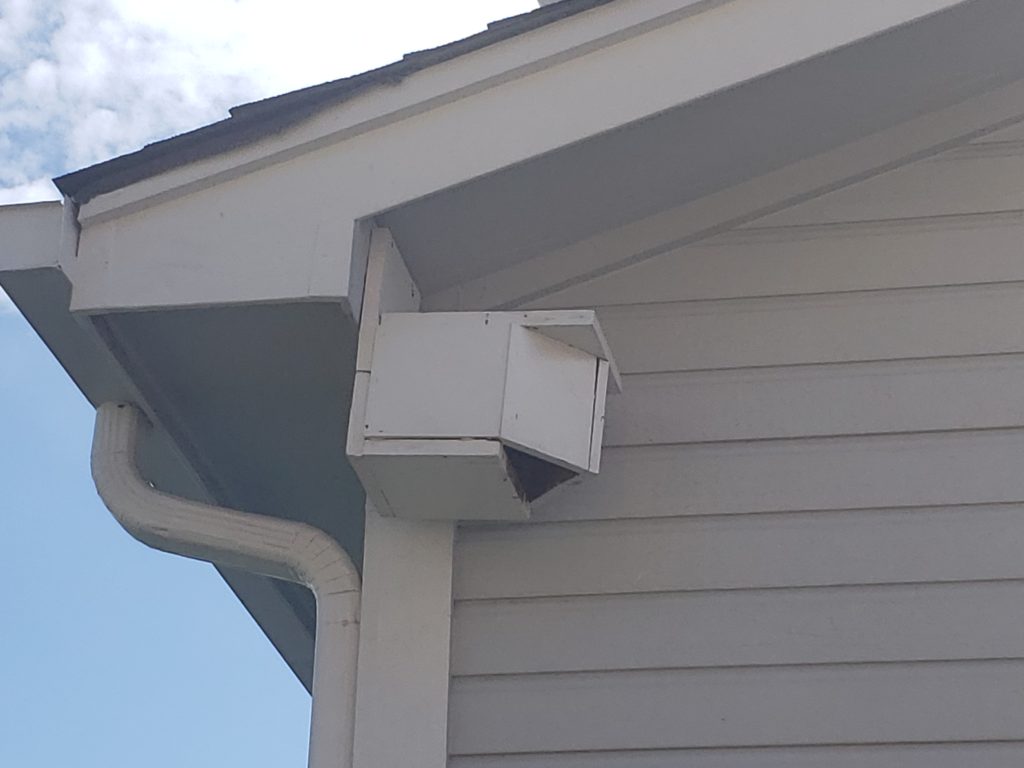
Underneath The Eaves
This custom-made nest box was built by Ethan after he noticed predators finding the House Finch nests in his former boxes. With its bottom entrance, this one is resistant to curious jays.
Other NestWatchers have documented House Finches using nest shelves and shallow cavities intentionally provided for birds (see gallery below). The House Finch’s flexibility in nest site choice means that it hasn’t become a serious competitor for nest boxes in North America.
Because at least some House Finches use nest boxes, caution is warranted among those who manage against invasive species. The female House Finch and her young are occasionally confused with House Sparrows, a non-native species in North America that many nest box stewards manage against. They can be told apart by differences in egg coloration and pattern, as well as nest shape. Males of these species are also very distinct from each other, as is their song. Because the House Finch is protected under the Migratory Bird Treaty Act, people who manage House Sparrows in boxes should take care to review these differences in the downloadable image provided below.
Have House Finches nested in your nest boxes, or do they stick to ledges, eaves, and vegetation? Regardless of the substrate, consider reporting the nesting data to NestWatch. Learn more about how to enter data in our FAQs.
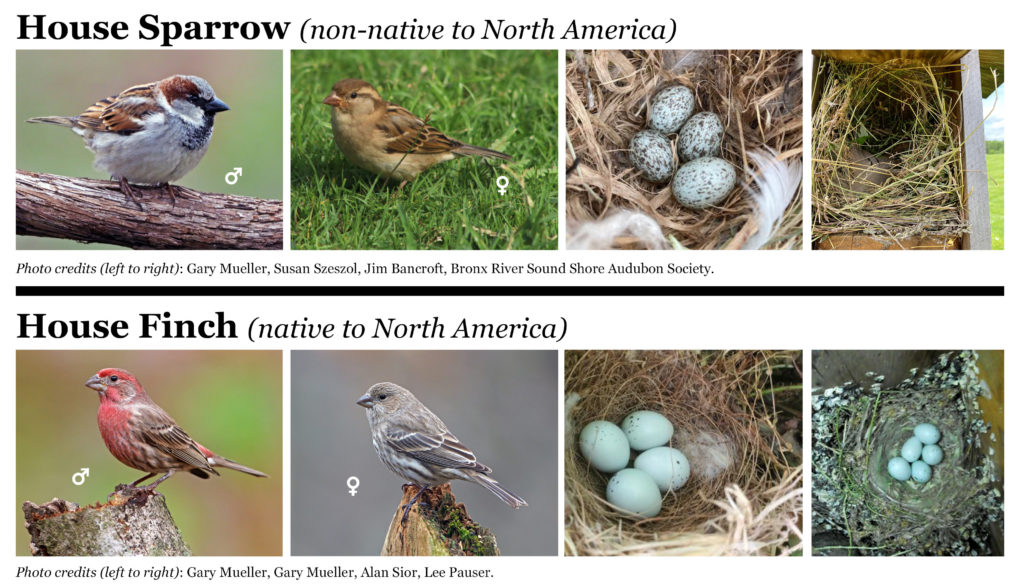
Is It A House Finch Or A House Sparrow?
References:
- Bergtold, W. H. 1913. A study of the House Finch. The Auk 30(1):40–73.
- Jackson, J. A., B. J. Schardien Jackson, and M. F. Hodges, Jr. 1986. First breeding of the House Finch in Mississippi. The Mississippi Kite 16(1):10–12.

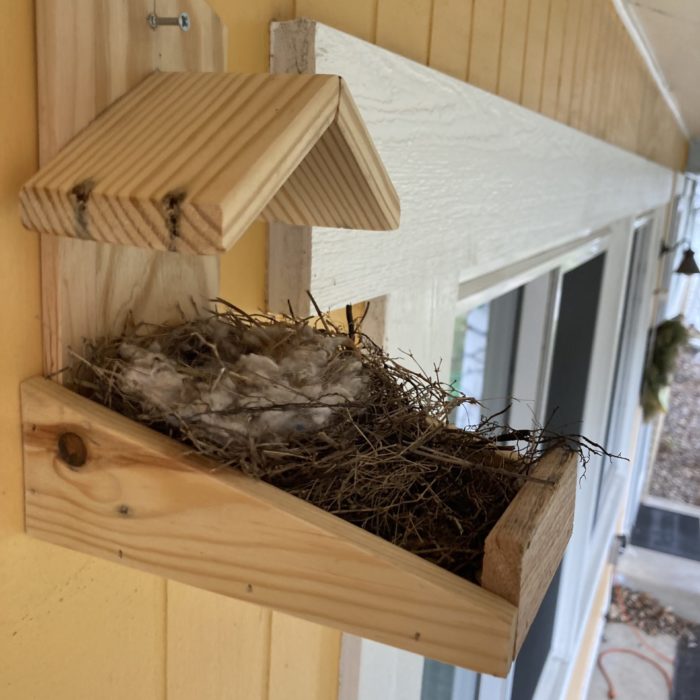
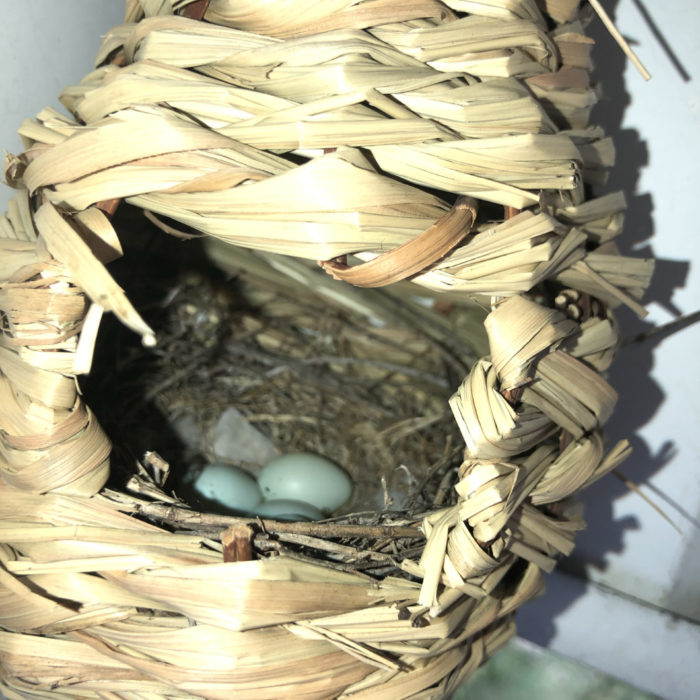
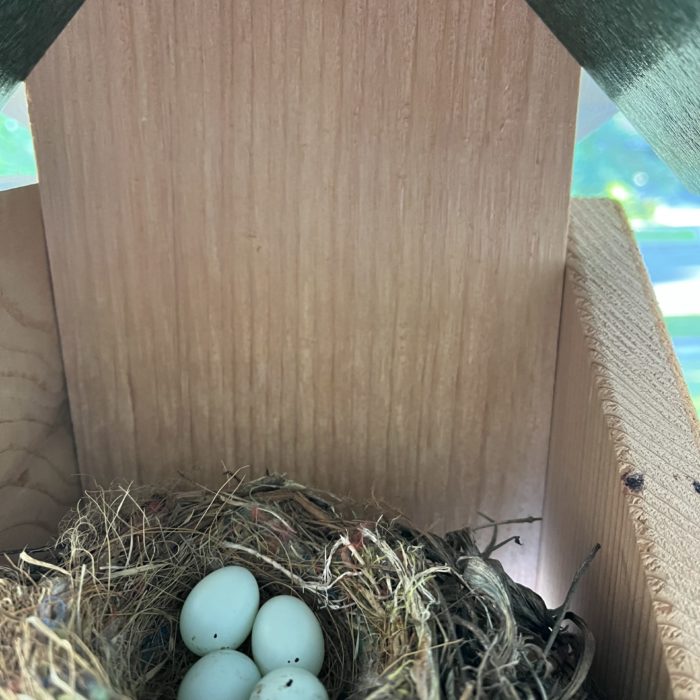
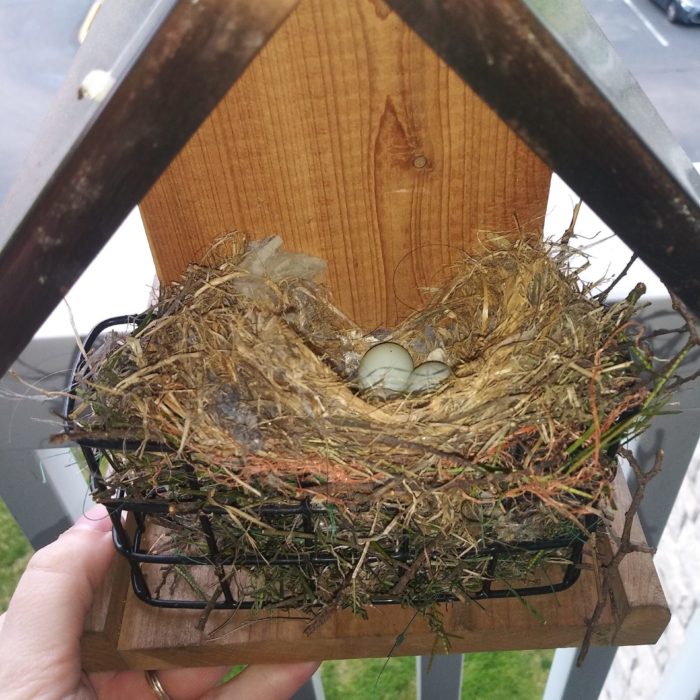
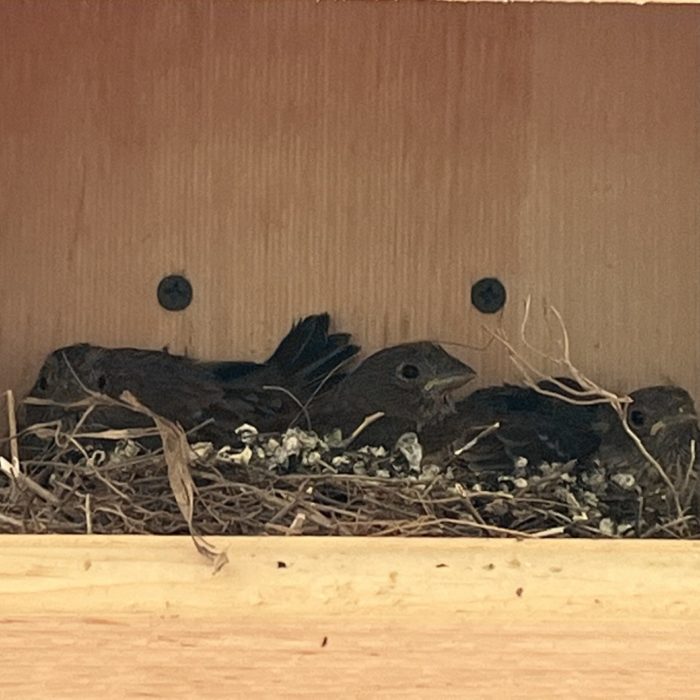

19 comments on “NestWatchers Document Rare Use Of Nest Boxes By House Finches”
Hi,
I live on Cape Cod and have a Lot of House Finches, which I Adore.
I have two blue bird boxes up, and have been lucky enough to attract them.
The blue jays keep wiping out the bluebird nestlings.
I had a pair of Carolina wrens successfully raise three chicks in my garage; as we leave the door open for them. It saves them from the jays.
If I attach a bluebird box to the house, will the Finches perhaps nest in it?
What else can I do to protect the Bluebirds.? Best
Blue jays should not be able to get at nestlings in a nest box. Is the hole size 1 1/2 inches? Is the depth of the box from the bottom of the hole to the floor at least 6 inches. If these parameters are what you currently have I would consider placing a 2 1/2 x 2 1/2 x 3/4 block of wood with a 1 1/2 inch hole over the existing hole of your bird house and/or increasing the depth of the bird house to 7 inches from the floor the the bottom of the hole.
To protect bluebirds from jays and any other bird that wants to raid the box, simply add a noel guard on the front of the box around the entrance hole. Easy and it works.
I wrote a paper on this in 1988: Hill, J. R. 1988. The eastern House Finch nesting in Purple Martin houses and gourds. American Birds 42:36-38.
A pair successfully nested in a 24-compartment, aluminum Purple Martin House in Pennsylvania.
Hi James,
Thanks for sharing this reference! I didn’t find this one in my search, probably because I wasn’t thinking about gourds or Purple Martin housing, and used key words like ‘nest box’ and ‘birdhouse.’ That is an interesting paper, and I wish I had seen it sooner. I can tell you that in my search of our photo records and comments about nest sites, none appeared to be in Purple Martin housing.
All the best, Robyn Bailey
What an interesting phenomenon! It must have been a real surprise to find finches in the owl and kestrel boxes!
It’s interesting. Thanks for your sharing. I would also like to have a few nesting boxes for house finches to attract to the yard. But the nesting boxes I can buy are all made with smaller holes for nightingales, and bluebirds. What size nesting box do I need for a finch house and could it be out-competed by House Sparrows or Starlings?
House finches are about the only birds at my feeders right now. Many many house finches. Looks like a successful breeding season. Why would I want to encourage further nesting? We’ve got juveniles everywhere.
I have house finches nesting in a hanging plant. how do I keep the plant alive with water and not disturb the nest? There are already 2 eggs in the nest I discovered today.
Hi Dawn, We have tips in this FAQ! Thanks for your question.
I’ve had 2 going in my carport in eve. It gets dark and they like fly around like no place to. Well tonight they flew in circles forever and decided to hide in Christmas wreath that on utility room door (in carport) we’re trying not to open the door tonight. But I need them at least somewhere else in the carport. Any suggestions of something to quickly put up so they feel safe and at least go there tomorrow. Thanks
I have Purple Finches building a nest on the eaves of my entryway and Robins keep destroying, and tearing apart the finches nest. How can I stop the robins from tearing apart the finches nest
Hello Diane, Unfortunately there’s not much that can be done in a situation like this. This natural competition will likely resolve itself. If you like, however, you can try to create more nesting space by building and installing a nest shelf elsewhere on your home – it may help attract one of these pairs so that there is room for both to nest. Find construction plans on our Right Bird, Right House tool.
Hello all. I have a house finch nesting in a plastic Purple Martin gourd in my Martin Colony. Martins are just arriving now. There are 4 finch eggs in the nest. I assume they will be of little concern to the martins.
2024 house finch made nest under eave on wind chime. All 4 babies survived and left nest about 12-14:days after hatching.
See bird image/video
https://youtu.be/2tDFaxFBGCI?si=Mzx3AFastG6iV5PD
I have a house finch nest with 5 eggs that started on a wreath on my front door . Due to the precarious hanging of the wreath, I made a small box and hung it more securely at the wreaths location and carefully transferred the nest to it. All is going well, the finch comes back quickly, even if disturbed when it leaves for a few minutes.
This morning one of the eggs had fallen out of the nest and was resting in the box so I carefully put it back. A few hours later, three eggs were outside the nest. I put them back and added some cotton batting around the nest to try and prevent the recurrence.
The finch has seemed nervous today, playing more with the eggs that I have observed. Any thoughts as to what she is thinking?
Hi Ron, We do not recommend handling a nest with live eggs/young inside – this is technically against the Migratory Bird Treaty Act and it’s often best to just let the nest continue naturally. If you find eggs out of the nest, this is usually due to a predator or similar disturbance, such as a Brown-headed Cowbird. Our best advice is to give the nest plenty of space and only visit it once or twice a week. This will give the nest the best chance at success, though please also know that nest failure is just as common, and is a normal part of life for birds. If birds are disturbed too much – including frequent visits by humans – there is the risk that they will abandon their nest completely. Feel free to email us at NestWatch@cornell.edu with any additional questions.
I have had house finches nesting in bird houses since the early 2000. I now have five houses for them and each spring typically get two sometimes 3 rounds of fledglings. In all that time only 2 babies didn’t make it. I didn’t realize it was not typical for house finches to use a bird house.
Hi Julie, What a fascinating behavior you’ve been able to witness! If you’re interested, please consider participating in NestWatch. We’d love to have a record of these nests. Learn more on our About page, and read instructions for how to enter data in our FAQ, if you’re not familiar with the process already. Feel free to send any other questions or photos of these nests to nestwatch@cornell.edu.